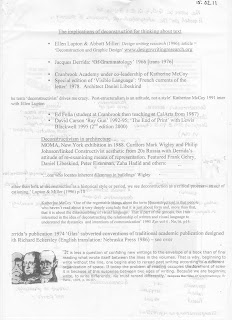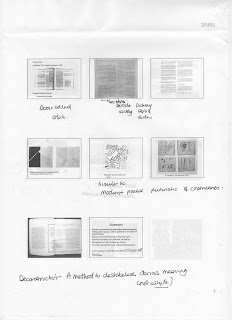Author (date) 'Title', full web URL
e.g. Miles, R (2010) 'A piece of Postmodern Graphics', www.graphics.com/graphics
Also, include a couple of sentences next to each image which describe why you think each image is Postmodern.
The Collection 100 brief led me to do extensive research on the Graphic Designer Barney Bubbles. He had a design background with five years studying design in the early sixties and went to work for Conran before 1967, the Psychedelic sixties morphing into 'Barney Bubbles'. So he knew the rules of design and was perfectly placed to break them.
The term Post Modern can be applied to a lot of Barney's work especially the Album cover designs from 1977 to 1983.This quote from the Guardian in 1990 made by Simon Reynolds underlines this idea' Generally post-modern artists like to mix the highbrow and the populists, the alienating and the accessible and to 'sample' elements from different styles and eras... now you can reinvent yourself endlessly, gaily pick n' mixing your way through gaudy fragments of a shattered culture'
This is also reinforced by Peter Saville:“The work of Barney Bubbles expresses post-modern principles: that there is the past, the present and the possible; that culture and the history of culture are a fluid palette of semiotic expression and everything is available to articulate a point of view.”
Peter Saville, Reasons To Be Cheerful: The Life & Work Of Barney Bubbles
These are four examples of his work which demonstrate a Post Modern style:
Bubbles, B (1977) 'Music is for pleasure album cover for The Damned'
This album cover does not attempt to disguise the Kandinsky inspiration, underlining the Post Modern concept of originality not of primary importance. The type face is almost unreadable again fitting with the Post Modern attitude of questioning convention ie that Typefaces are simple, legible and readable.
Barney designed several similar typefaces. one notable being for the NME Book of Modern Music, a free supplement which preluded the redesign he did in 1978 :
Bubbles, B (1978) ' The NME Book of Modern music'
This is a borrowed from 20's Russia, 60's Britain and Beyond.
Bubbles, B (1977) 'Front cover, 7" sleeve. Your Generation/Day By Day, Generation X, Chrysalis'
Berlewi, H (1924) 'Composition In Red, Black And White.'
Generation X's manager John Ingham was looking for a distinctive art direction for Generation X when they were directed towards Constructivism by an Art curator friend. By coincidence Barney, Art director for Stiff Records, also loved this period and they were brought together by John's girlfriend Sue Spiro who was working at Stiff records.
The Your Generation sleeve is one of the clearest examples of Barney’s distillation of art history references. Using Berlewi’s painting as a springboard, Barney reassembled the elements into a multi-layered piece which accurately expressed the visual minimalism and energy of the punk period, led by the “45″ pun on the rpm of the 7in single contained within, and the geometric representation of a record being played from above.
The deliberately off register CMYK on Elvis Costello and the Attractions This year's Model is another example of a Post Modern aesthetic. The E and T appear to have been cut off. Apparently when this went to America the record execs didn't get the Joke so the album was released with the straight cover. This is a good example a Post Modern Graphic Designer with a sense of humour who did not take himself too seriously or feel he had to follow the rules.
Bubbles, B (1978) 'This Years Model album Cover Elvis Costello & the Attractions'
Jeffrey Keedy is a Graphic Designer who graduated from the Cranbrook Academy in 1985. In 1989 he designed a typeface called Keedy Sans. To quote the designer from the Emigre website 'Most typefaces are logically systematic; if you see a few letters you can pretty much guess what the rest of the font will look like. I wanted a typeface that would willfully contradict those expectations. It was a typically postmodern strategy for a work to call attention to the flaws and artifice of its own construction. But I never thought of it as being illegible, or even difficult to read. I have never been very interested in pushing the limits of legibility for its own sake. Absolute clarity, or extreme distortion, is too simplistic a goal, and it is ground that has already been well covered. I wanted to explore the complex possibilities that lie somewhere in between and attempt to do something original or at least unique.
At the time I had been using the American highway Gothic typeface in my design work that I cut and pasted from a highway signage manual. Another vernacular influence was the "f" from the Fiat logo. But I was not only quoting low vernacular sources; it was important that I mixed in high design sources as well. So I was thinking about Akzidenz-Grotesk Black, which was somewhat exotic in America, because I liked Wolfgang Weingart's typography. Overall I wanted a typeface that was similar to Cooper Black, extremely bold with a strong idiosyncratic personality. I think it is a very postmodern typeface in that it included "high" and "low" vernacular quotation, and it is self-consciously crude and anti-aesthetic in reaction to the slickness of Modernism.' http://emigre.com/EFfeature.php?di=100
Keedy, J (2002), 'Emigre Type Specimen Series Booklet No. 4 Keedy Sans'
i-D magazine was launched in 1980, the covers were created by Art director Terry Jones. The strong colours, use of collage and experimental type quickly started to both represent and influence the rise of Postmodern and New wave youth culture.
i-D Magazine July 1981 (Accessed 20 February 2011)
Graphics by Malcom Garrett which is a nice link as Malcom Garrett quotes Barney Bubbles as a huge influence on his career
Tantrum Magazine May 1984 (Accessed 20 February 2011) photograph of Madonna by Mark Lebon
Carin Goldberg is an American Graphic Designer whose book cover designs in the 80's became iconic of Postmodern style, especially the 1986 reissue of Ulysses by James Joyce
Golberg, C (1986) 'Front cover Ulysses by James Joyce Random House' http://caringoldberg.com/BookJackets/more/jackets_more_44.html
Ironically after reading this Blog Interview with her I can see she is slightly frustrated by the 'Postmodern' label, particularly with the constant referance to Ulysses. In her 30 year career she has only ever tried to solve problems in the best way she can. Her Postmodern aesthetic is more succinctly demonstrated by considering another of her book cover designs.
In an Ellen Lupin article she discusses how Goldberg brought the Postmodern ideas of ' decoration, pastiche, and eclecticism' to Book Design. The '1985 cover for Rainer Maria Rilke’s Sonnets to Orpheus, she borrowed from the graphic style of the Vienna Secession, creating densely ornamental lettering locked together within a heavy linear framework. Her design is directly modelled after Josef Hoffmann’s 1903 identity for the Wiener Werkstatte.' Available at http://elupton.com/2010/07/goldberg-carin/ (Accessed 20 February 2011)
Goldberg, C (1985) 'Rainer Maria Rilke’s Sonnets to Orpheus' http://caringoldberg.com/BookJackets/bookjackets13.html
































